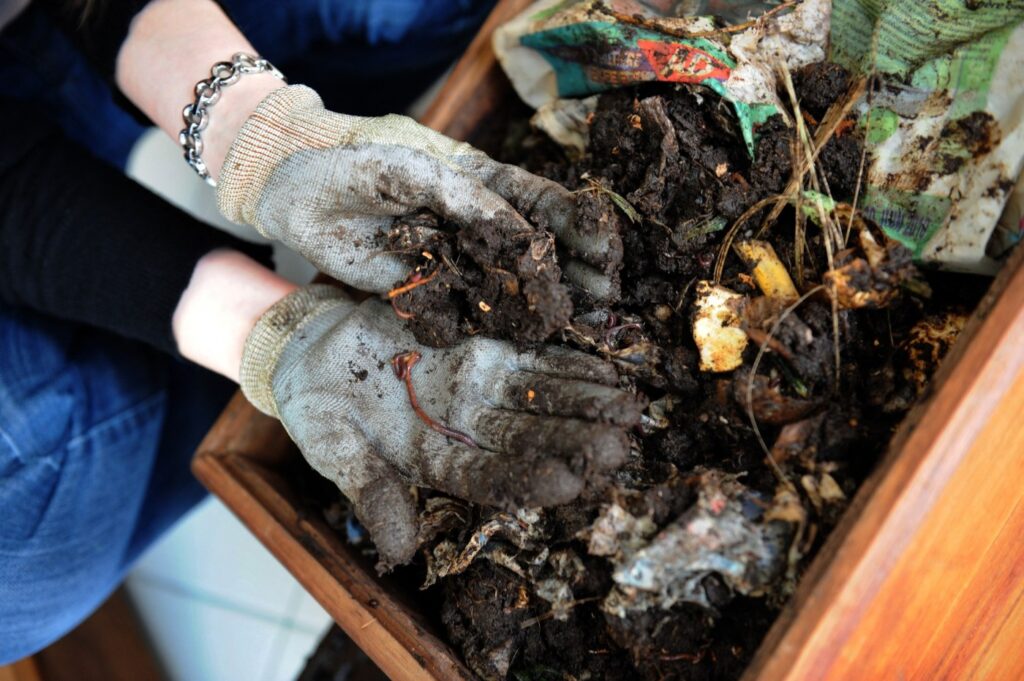
In a world increasingly driven by eco-consciousness and sustainability, innovative solutions are emerging to address our environmental challenges. One such solution is vermicomposting, which transforms organic kitchen waste into nutrient-rich soil through earthworms. Often referred to as the “black gold” of composting, vermicomposting is an excellent solution for households with limited composting space seeking to reduce household waste and improve their soil.
At the heart of vermicomposting lies a simple yet astonishing principle: Earthworms can break down organic matter and convert it into a substance known as vermicompost. The compost is a potent blend of minerals, beneficial microorganisms and nutrients that greatly enrich soil fertility. Unlike traditional composting methods that may take months or even years to yield results, vermicomposting accelerates the process to a matter of weeks.
Households can easily set up a vermicompost system within their homes, according to Dick Miner, aka the “worm man of Alcatraz.” A retired microbiologist and active vermicomposter, Miner maintains the composting solutions on Alcatraz Island. His compost has won many awards at the Marin County Fair.
“Vermicompost systems are quite easy to set up and maintain,” he says. “There are many homemade systems plans available online.”
Commercial bins can be purchased online, or plastic storage bins can be fitted to house a worm colony. Your bin size will dictate the size of your colony and, therefore, the amount of kitchen scraps you can feed and compost you produce. A larger population can be housed in bins around 18 inches wide by 24 inches long and 18 inches deep.
Starting a vermicomposting bin is easy. According to Miner, the best first step is to “find an appropriate room (mild temperatures year-round). Prepare worm bedding (shredded newspaper, egg cartons, cardboard, coconut coir). Order worms from providers (red wigglers work best).”
Once you have a system set up, your vermicompost is fed with almost any organic plant-based kitchen scraps. Vegetable scraps, cores, peelings, rinds, leaves, stems and roots are great food sources. Coffee grounds, unbleached filters, tea bags, bread and corn cobs can also be added. Avoid adding onion, garlic, peppers or citrus fruit or peels. Never add meats, fats, dairy or citrus. Start slowly. An overly enthusiastic composter could end up with a smelly bin. It takes 2,000 red wigglers to consume a pound of food a day. Gauge your worm quantity needs by the volume of your household scraps.
Once your compost bin is up and running, it requires little maintenance. After three to six months, you’ll start to have useable vermicompost. When little or no original bedding is visible, and the contents of the bin are reduced in bulk and mainly consist of worm compost, which is brown and “earthy” looking, it’s time to harvest. Castings can be harvested anywhere from two and a half months to every six months, depending on how many worms you have and how much food you’re giving them.
To harvest your compost, move everything to one side of the bin. Pick out partially decomposed materials and push them to the other side. Place some food on top of the partially decomposed materials. Replace the lid and leave it alone for a couple of weeks. During that time, the worms should migrate over to the new food. Once they’ve gone to the other side, harvest the castings.
Make sure you don’t remove any worms in the process. Then, give the worms new bedding mixed in with some residual compost.
Harvested compost should have a good, clean, earthy aroma. The vermicompost can now be mixed directly with your potting soil and/or used to make compost tea. Compost tea is a liquid plant food loaded with microorganisms that help feed your plants with readily available nutrients. To make vermicompost tea, mix water and the compost together at about a 1:5 ratio of compost to water. Let this mixture sit for three to five days. During this time, beneficial microorganisms will leach into the water, creating a nutrient-rich tea. Strain out any large pieces and feed your plants.
Related Articles
How to bring some colorful plants into your winter garden
What to do about invasive ivy when it’s covering a wall or fence
What you can plan to plant in your garden this winter
12 Christmas and holiday gifts for the gardeners in your life
3 insect pests that can cause problems in the garden
Vermicomposting can be a great way to manage household waste in a small-scale setting.
“Most vermiculture systems are easy to maintain. One just needs to have a room temperature control and a watchful eye on bedding moisture,” Miner says.
Vermicomposting is good for the soil and environment and can be an enjoyable family activity.
Sponsored by UC Cooperative Extension, the University of California Marin Master Gardeners provides science- and research-based information for Marin home gardeners.
